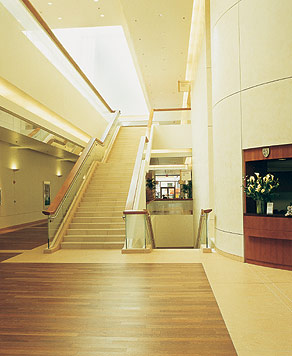 |
|
Inside: An environment designed to uplift patients, physicians and researchers in support of their efforts to heal. |
|
A new building advances Stanford’s plan to raise its profile in cancer treatment and research
By Rosanne Spector
Photograph Leslie Williamson
On March 1, the first Stanford patients stepped into the light-filled atrium of the new cancer center. Gone were the long windowless hallways of the old cancer facilities. It was opening day for Stanford’s new center and the start of a new era in cancer research and treatment at the medical center.
With the cancer center’s opening, patients experience a level of comfort and convenience on a par with Stanford’s clinical care. But the new building is more than just a big deal to patients. It’s a key player in the medical center’s long-range plans to raise its already high stature as a cancer treatment and research center.
For a decade, medical center and university leaders have worked toward creating the facility. They won support within Stanford. They negotiated with neighboring Menlo Park and Palo Alto, which had concerns about a bigger, busier medical complex’s potential environmental impact. And they raised the funds needed to make their $147 million vision real.
Now the work begins to pay off. When patients enter the new center, they are greeted by escorts who guide them to their appointments. They walk through an environment designed with their needs foremost, moving through the atrium, past a flat screen display of a waterfall and into their appointment, which, if they wish, begins with a 15-minute massage.
The new 150,000-square-foot facility, designed to welcome patients in a healing environment, is more than double the space previously dedicated to outpatient cancer care. The medical center expects 70,000 cancer-related service billings this year — 3,000 more than last year.
The building’s design aims not only to pamper patients but to encourage interdisciplinary faculty encounters. In the old facility, faculty worked within departmental boundaries. Now they’re housed according to cancer specialty, with surgeons and oncologists specializing in a single type of cancer all rubbing elbows.
Some of the excitement about the new cancer center comes from the role it’s expected to play in Stanford’s effort to join 39 other institutions in becoming a National Cancer Institute-designated Comprehensive Cancer Center — one of the school’s major goals. The NCI ranks high in importance the grant applicant’s ability to provide patients a comfortable environment and to support a thriving research program.
The NCI designation would mean more money for cancer research and would make Stanford an even more appealing collaborator for multisite clinical trials. Stanford already has about 200 clinical trials in adult cancer treatment under way and about 100 in pediatric cancer treatments.
“I look forward to the challenge and opportunity of making the new Stanford Cancer Center one of the most significant treatment facilities in the world,” says the center’s newly recruited director, world-renowned radiation oncologist Steven Leibel, MD, the Ann and John Doerr Medical Director of Stanford Cancer Center.
Leibel will be leading Stanford’s 200 cancer specialists in a healing and energizing environment and working with the most advanced technology available. Stanford was a great center of cancer care and research before. Now, what’s stopping it from being the greatest?
Comments? Contact Stanford Medicine at

